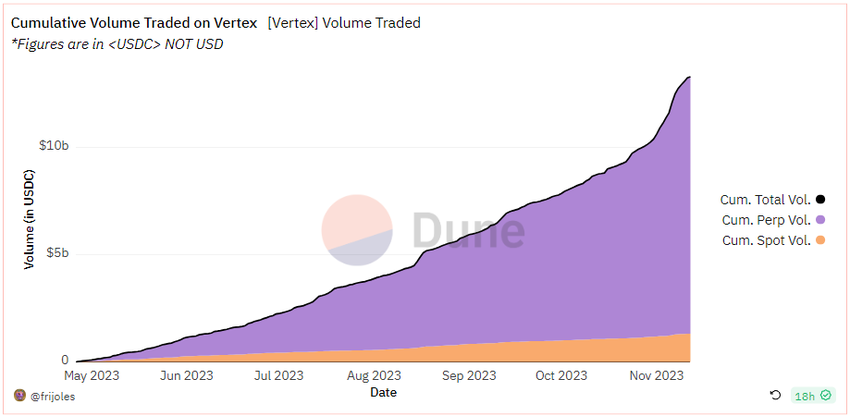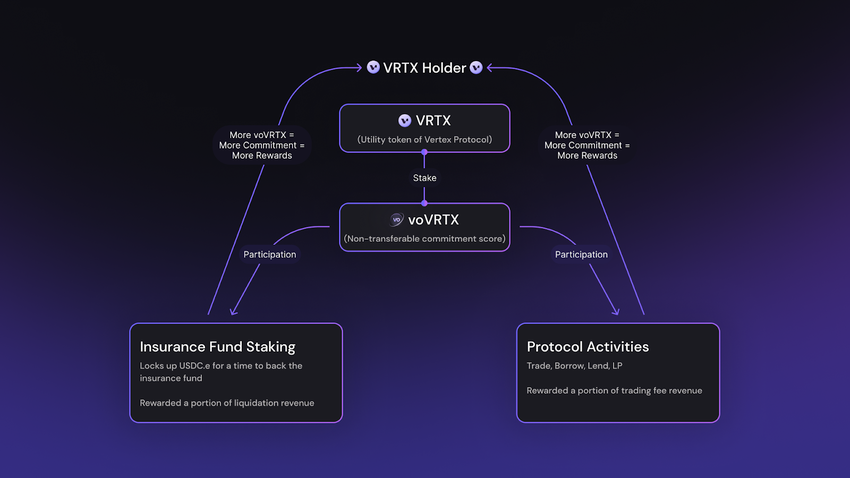Vertex Protocol has generated considerable excitement in DeFi by bringing to market the first vertically integrated decentralized exchange (DEX) to compete with incumbent centralized exchanges (CEXs).
While DEXs tend to be singular in the use cases they address – for instance, Uniswap is for spot markets, Aave is for borrowing and lending, and dYdX is for perpetuals – CEXs tend to offer all these options on a single platform.
Vertex Protocol accomplishes many of the same ends while also achieving a highly performant decentralized exchange.
Vertex differentiates itself by offering a holistic trading solution that combines the speed and functionality of an off-chain order book with the decentralization of an on-chain automated market maker (AMM). Vertex offers universal cross-margin accounts for trading on Arbitrum, enabling features such as leveraged trades, borrowing, lending, and liquidity provisioning – all in one place.
Here are some of the other distinct attributes of Vertex Protocol:
Sponsored- Exceptionally Competitive Fees: With taker fees set between 0.02% and 0.04%, and zero fees for maker
- Low Latency in Order Matching: Vertex is designed to match orders within roughly 30 milliseconds, rivaling centralized exchanges and surpassing other DEXs. Most of the time, latency from order placed to order filled will be around 15 milliseconds. This speed is thanks to Vertex’s off-chain sequencer which hosts the order book and matching engine.
- Self-Custody: Despite the use of the off-chain sequencer, all settlement occurs on-chain, which means that users never forfeit control over their assets. There can never be opaque misuse of customer funds because the user always retain control over their funds on-chain.
- Built-in MEV Resistance: One major benefit of the sequencer is that it reduces the maximal extractable value (MEV) issues often associated with DEXs. Validators on Layer 1 networks like Ethereum can typically front-run traders who are using fully on-chain DEXs. MEV extraction on Vertex is less valuable due to the low-latency performance of the sequencer.
- Tailored Trading Experience: Vertex Protocol’s interface is fully customizable, offering traders an array of options to personalize their trading environment.
- Built for Automation: With a robust API and SDK, Vertex caters to institutional traders with automated trading systems. The benefit is that HFT-friendly trading infrastructure brings massive liquidity to the exchange, which improves the trading experience of all traders by minimizing slippage and tightening bid-ask spreads.
How Has Market Been Responding?
One only needs to look at the strong performance indicated by Vertex’s volume data to get a sense of how DeFi natives are starting to fit Vertex into their DeFi needs.

Even within the worst bear market in crypto history, Vertex has hit over $12 billion in total trading volume in just seven months since launch.
Sponsored SponsoredA Token Launch
What’s more, Vertex Protocol is now launching a utility token, VRTX.
In crypto there is little more exciting than when a stellar project launches its own token. This generates a ton of buzz and attention, as well as speculation about the utility of the token.
Let’s first talk about tokenomics.
VRTX serves as the utility token for Vertex Protocol, with a fixed maximum supply of one billion tokens. The purpose of VRTX is to align the interests of the Vertex community (aka the traders and users on the exchange) by rewarding contributions and users with long-term perspectives.
Initially, VRTX will be allocated according to the trading incentives program during the first seven epochs following the launch on the mainnet. After this period, a continuous incentive phase will persist for 72+ months to gradually distribute the remaining VRTX tokens.
Staking VRTX is encouraged as a demonstration of commitment to the enduring growth of Vertex Protocol. By staking VRTX, users obtain voVRTX, a non-tradeable “user score” that reflects a user’s long-term engagement and dedication to the exchange. The voVRTX score is instrumental in determining the distribution of user rewards. Those who maintain their involvement with the protocol over time, as indicated by their voVRTX score, will be eligible for a pro rata portion of the protocol revenue – distributed as USDC.e rewards.

One way to participate in the exchange and qualify for voVRTX-based rewards is through active engagement – trading, lending, borrowing, and contributing to liquidity pools. Up to half of Vertex’s trading fee revenue for each epoch, excluding sequencer fees, will be directed to the Protocol Treasury to fund rewards. The allocation of these rewards will be based on the users’ sustained involvement and dedication to Vertex, as quantified by their voVRTX score.
SponsoredAnother avenue for earning voVRTX-based rewards is by supporting the insurance fund with USDC.e. Contributors to this fund can receive a share of the proceeds from liquidations, with an increased share for those with higher voVRTX scores. In the event of a liquidation, these contributors’ USDC.e may be used to cover the settlement for any potentially underwater positions amid extreme volatility.
The launch of VRTX is certainly a highly anticipated event with months of build-up via the trading rewards program.
Token Generation Event: VRTX Liquidity Bootstrapping Auction
Breaking away from traditional token launch methods, Vertex Protocol has opted for an innovative Liquidity Bootstrapping Auction (LBA).
Vertex Protocol is currently running the LBA from Nov. 13 to Nov. 20. The LBA aims to establish the initial liquid market for VRTX. Over the course of this week, the market for VRTX will develop from two distinct liquidity pools – one for VRTX and one for USDC.e.

Participants who have accrued VRTX through trading activities on Vertex Protocol during the initial seven epochs have the option to seed the VRTX liquidity pool during the week-long LBA. The USDC.e pool is open for liquidity contributions from anyone during this period, even if one has never traded on Vertex before.
Following the LBA, these two pools will merge to create a standard constant product Automated Market Maker (AMM), marking the beginning of the liquid market for VRTX.
Sponsored SponsoredLBA participants (those who provide liquidity to either or both pools) will be compensated for their role in two ways. The first is through the LP trading fees generated by the pools. The second is through VRTX rewards earmarked as LP incentives for the LBA.
Vertex’s LBA is designed to allow the market to naturally arrive at a fair value for VRTX. Previous methods of token launches have tended to favor people who used bots to trade faster than any normal human can trade. The LBA extends the price discovery process over the course of a week, which greatly reduces the advantage that bots will have.
What Happens to Liquidity After 7 Days?
Funds contributed towards liquidity provision for the LBA will undergo a phased release over a 120-day vesting period.
After the LBA ends on Nov. 20, the VRTX and USDC.e contributions will be combined to form the VRTX-USDC.e liquidity pool within the Vertex AMM system. Contributors to the LBA will be granted an LBA position, akin to liquidity provider (LP) positions in a traditional x * y = k AMM, signifying their proportional share in the pool.

These LBA positions will be subject to a 60-day lock-up period during which no withdrawals of liquidity will be permitted. Following the initial 60-day lock-up after Nov. 20, one-third of a participant’s holdings will become immediately accessible. The remaining two-thirds will be evenly distributed over the subsequent 60 days.
Conclusion
Vertex Protocol is redefining the DEX platform, setting a new standard in terms of fee structure and capital efficiency for crypto trading. It is the first to fuse spot trading, perpetuals, and money markets seamlessly.

